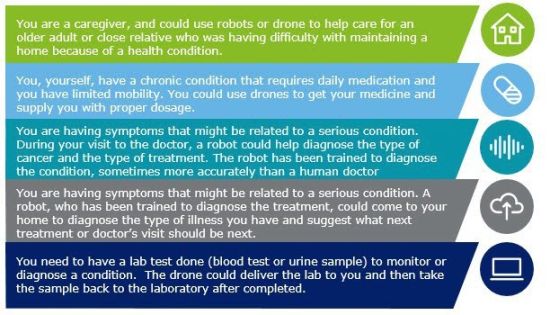It's now nearly two years since we published our report Healthcare and Life Sciences Predictions 2020: A bold future? Since then we have had numerous conversations with clients and other stakeholders on our vision of the future. We acknowledged that our view was an optimistic one but also that the technology to delivery these predictions was already available and even being deployed, albeit not at scale. I was fascinated to read a recent article from my colleague and fellow Research Director at the US Center for Health Solutions, Sarah Thomas, on healthcare consumers' appetite for technology enabled care and her own take on the potential ways of delivering care to people at homes. I therefore thought I would use this week's blogs to share Sarah's insights with our readers.
A glimpse into the future
Earlier this month, my husband and I went to see the new Star Trek movie. As usual, it was a lot of fun. It tells a great story that features moral dilemmas and heroism and presents a vision of the future. That future vision includes transportation, architecture, translation, space travel (of course), and even health care. But, technology can fail – in the movie, the ship's doctor needs to provide health care to Spock. "Bones" is without his trusty tricorder for diagnosing and treating illness and has to rely on memory of Vulcan anatomy and old fashioned ways of preventing blood loss.
While this may not be what health care will really look like in the future, it is interesting to speculate. How fast do we expect change and adoption to happen? Technology-enabled care, telemedicine, sensors, remote patient monitoring (RPM), and the Internet of Things (IoT) are creating opportunities for more care to happen outside of traditional health care settings like doctors' offices and hospitals, and instead take place where people live, work, and play.
Engaged consumers, value-based care payment models spurred by the Medicare Access and CHIP Reauthorization Act of 2015 (MACRA), a growing aging population (that prefers to age in place), and increasing chronic disease prevalence are some of the things driving the development of technologies to support health care outside the traditional setting. Telemedicine, sensor technologies, and IoT hold promise to help improve and personalize care – and create new value for industry stakeholders. Importantly, these technologies have the potential to reduce costs by keeping patients out of the hospital, lowering readmission rates, and promoting adherence to care plans.
As more technology-enabled care is offered, will consumers want
it? What will they like and not like about it? The Deloitte Center
for Health Solutions
2016 Survey of US Health Care Consumers explored consumer
expectations, preferences, and attitudes around technology-enabled
care. Specifically, we explored consumer interest in technologies
for health care services, barriers to adoption, and motivations and
values around the use of health care services.
Some highlights include:
- Consumers have an appetite for using technology-enabled care. Seven in 10 of the respondents say they are likely to use telemedicine, RPM, robots or drones.
- Half of consumers are likely to use telemedicine – which makes it the most popular technology among consumers. In particular, they are interested in using it for post-surgical care and chronic disease monitoring.
- Particular subgroups are especially keen on these technologies. We saw this especially in those who have chronic diseases, Millennials using telemedicine, and seniors using RPM.
- Caregivers are a key population. More consumers say they are likely to use sensor technology when caring for others (caregivers) than on themselves. Current and previous caregivers are also more likely to say they would use telemedicine and RPM technology than non-caregivers.
- Consumers demand high quality, personalized care and want assurance that their personal information will be safe. About a third express concern about the security of their information or that it might be misused. Four in ten think that care quality could be lower than if they saw a provider in person (43 percent for telemedicine, 35 percent for RPM).
- While adoption levels are growing, the use of technology in self-health care is still in early days. Most commonly, consumers report using technology to fill prescriptions (58 percent). Use drops off from there, however, where one-third or less report using other types of health technologies (e.g., paying medical bills online, monitoring health issues).
In addition to telemedicine and RPM, we decided to push the envelope and ask about some technologies that are imaginable but not yet very common in health care consumers' experience – robots and drones.
While drones and small robots are still a novelty to many, researchers say that in the next several decades, they may be able to assist older individuals with health risks who want to stay in their homes as long as possible.1 Some of the tasks that may be possible include getting medication from another room, household cleaning, and other tasks that could reduce the risk of falls in older adults who live alone.
We assessed consumer interest in using robotics and drones in five futuristic scenarios:

Interest among consumers is relatively high in using robots and drones in these scenarios. Forty percent of consumers are interested in using drones to help with self-care for a chronic disease (medication assistance). Interest is just as high in having robots assist their doctors diagnose a condition. Fewer are interested in using robots to diagnose conditions without a doctor (32 percent) or to monitor others (as a caregiver) (35 percent).
My take is that we likely will have technology in the future that we haven't even dreamed of today and that consumers, whether patients or caregivers, and their clinicians may adopt technologies that both work as intended and show their value. To the extent we can harness new technology to help people remain in their homes as they age and improve the quality of their lives, I say bring it on!
The content of this article is intended to provide a general guide to the subject matter. Specialist advice should be sought about your specific circumstances.
